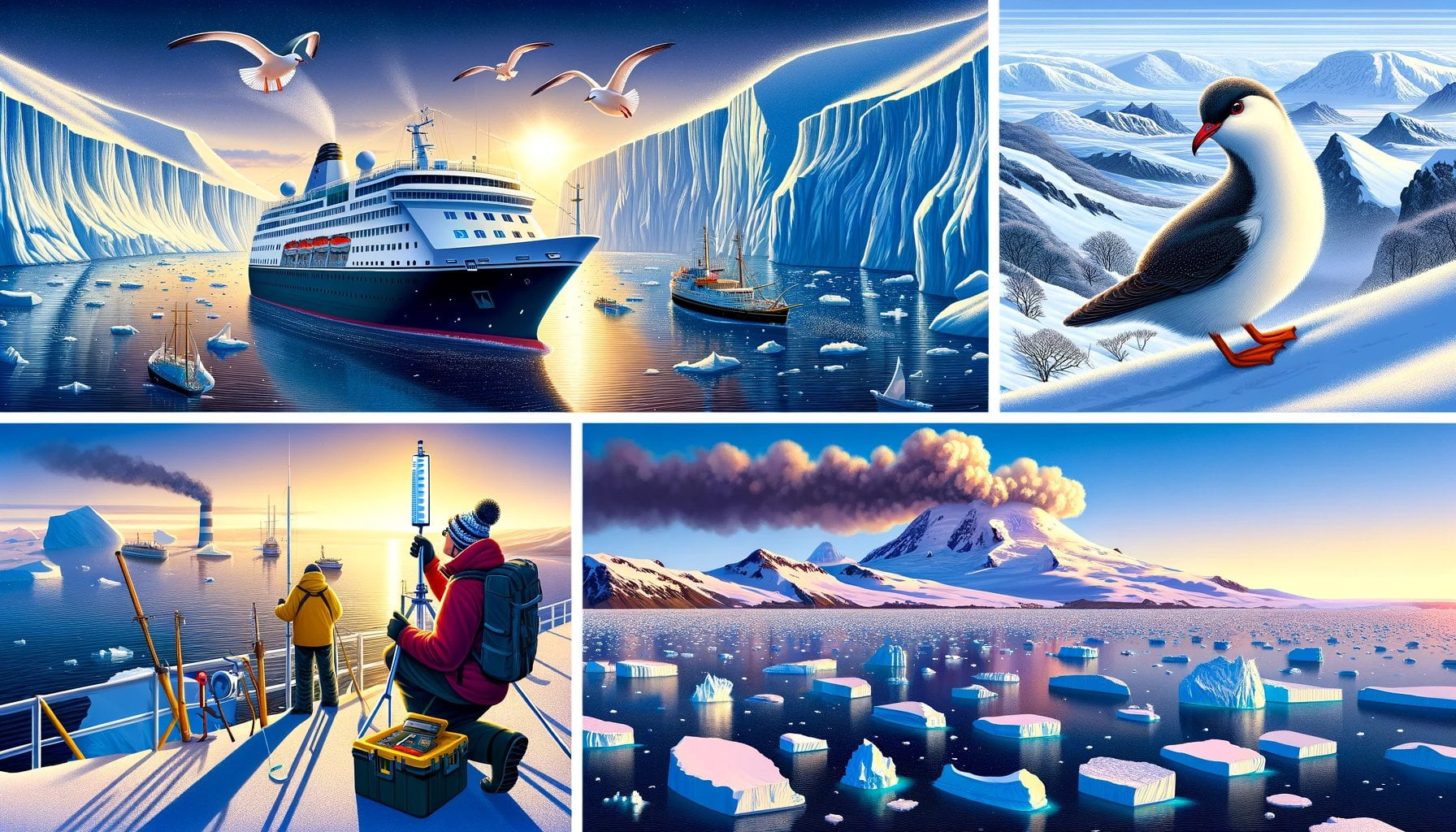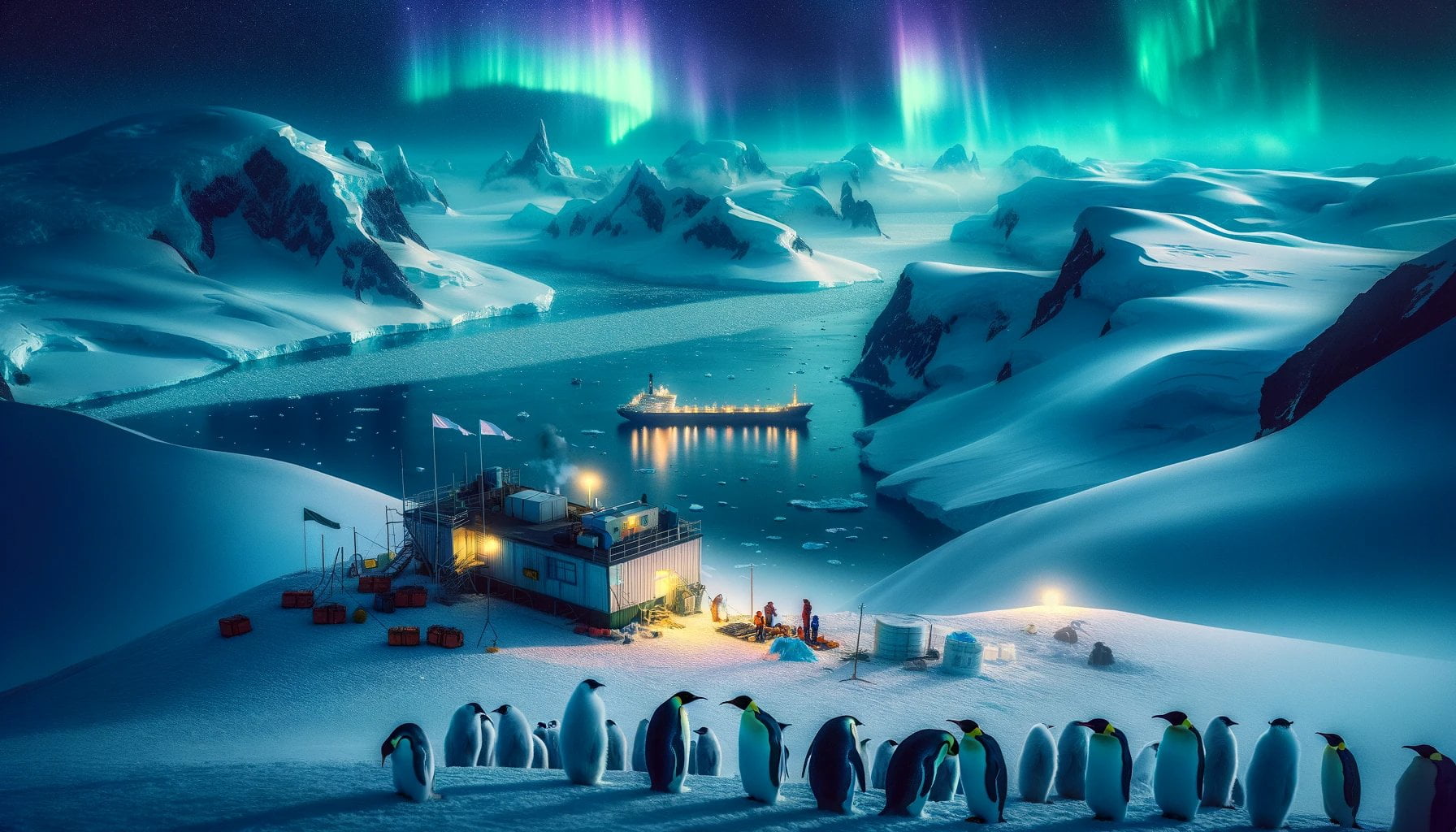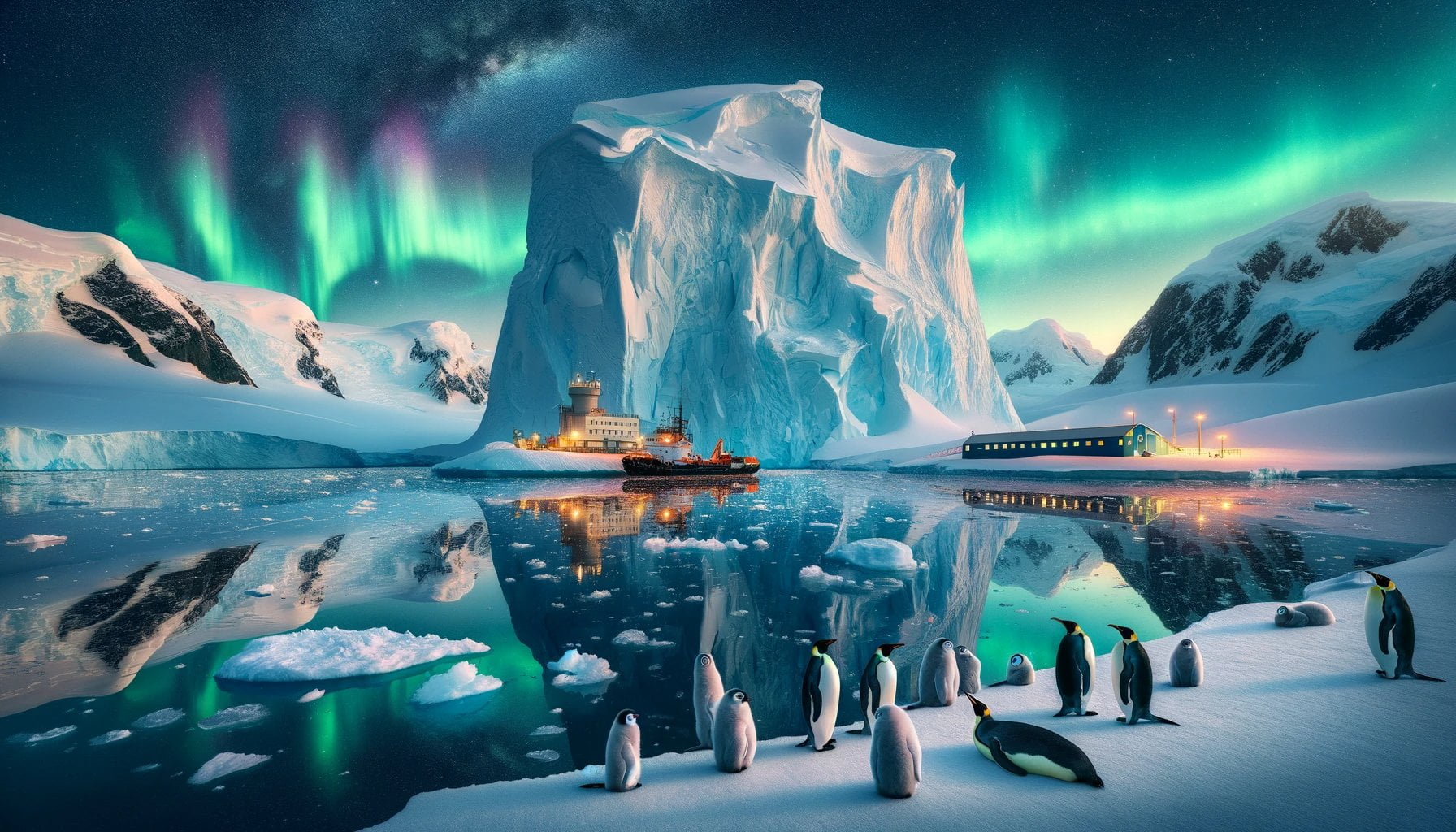Discover the enigmatic wonders of Antarctica with these five fascinating facts that will take you on a journey through one of the world’s most remote and mysterious continents. From its icy landscapes to its captivating wildlife, Antarctica never fails to astound and mesmerize explorers and scientists alike. Prepare to be captivated by the awe-inspiring beauty and the remarkable discoveries awaiting in this frozen wonderland. Get ready to uncover the secrets of Antarctica as we delve into the five most intriguing facts about this enigmatic continent.

Key Takeaways:
- Antarctica is home to the majority of the world’s fresh water and ice, with about 90% of the world’s ice and 70% of the fresh water.
- Despite its icy appearance, Antarctica is classified as a desert due to its extremely dry conditions, with very low precipitation and humidity.
- Millions of years ago, Antarctica had a much warmer climate and was home to forests and dinosaurs.
- The Antarctic Peninsula is experiencing significant warming due to climate change, which is impacting its delicate ecosystems.
- Antarctica does not have a time zone, capital city, or official language, as it is a continent beyond national borders.
- In Antarctica, any direction you choose to go will lead you towards the northern hemisphere, as it is the southernmost point on Earth.
- Antarctica is home to several active volcanoes, some of which are hidden beneath the surface of the ice.
- The subglacial lake in Antarctica called Lake Vostok flows blood red due to its high iron content.
- With its vast open spaces, Antarctica experiences incredibly strong winds, with speeds reaching over 200 mph.
- Due to limited medical facilities, workers in Antarctica often have to remove their wisdom teeth and appendix to prevent medical emergencies.
These key takeaways provide a glimpse into the enigmatic wonders of Antarctica, including its ice sheets, unique wildlife, and extreme weather conditions.
What are 5 interesting facts about Antarctica?
Antarctica, a continent of ice and snow located at the southernmost point of Earth, is a place of wonder and mystery. Here are 5 fascinating facts about this enigmatic land:
1. Antarctica holds the majority of the world’s freshwater and ice.
Did you know that Antarctica contains approximately 90% of the world’s ice and a staggering 70% of its freshwater? This frozen expanse is a vital source for Earth’s water supply, making it a significant reservoir that helps regulate global climate patterns.
2. Antarctica is a vast desert despite its icy appearance.
Despite its icy landscapes, Antarctica is actually classified as a desert. With its minimal precipitation and incredibly low humidity, it is one of the driest places on Earth. This incredible contrast between its icy exterior and desert classification is just one example of the paradoxical nature of Antarctica.
3. Antarctica used to be home to forests and dinosaurs.
Believe it or not, Antarctica’s past holds secrets of a much different climate. Millions of years ago, Antarctica had a much warmer climate with lush forests and roaming dinosaurs. The remnants of this ancient world can still be found in the continent’s geological formations, providing a glimpse into its fascinating history.
4. Antarctic Peninsula is experiencing rapid warming due to climate change.
Climate change is impacting every corner of the Earth, and Antarctica is no exception. The Antarctic Peninsula, in particular, is one of the most rapidly warming areas on our planet. Rising temperatures are causing the delicate ecosystems of this region to face significant challenges and changes.
5. Antarctica is a place beyond borders.
Unlike other continents, Antarctica does not have a specific time zone, capital city, or an official language. This is because Antarctica stands as a symbol of international cooperation, reserved for scientific research and exploration. It serves as a reminder that there are still places untouched by political boundaries.
These facts offer just a glimpse into the wonders and mysteries of Antarctica. From its role in regulating the Earth’s climate to its ancient history and unique geopolitical status, this frozen continent continues to fascinate and inspire exploration.
Check out these fascinating facts about Antarctica that will blow your mind!
– facts about antarctica
Curious to know 20 mind-blowing facts about Antarctica? Click here to find out!
– What are 20 facts about Antarctica?
Unveil the secret fact about Antarctica that will leave you in awe!
– What is Antarctica’s secret fact?
Discover three captivating and intriguing facts about Antarctica right here!
– What are 3 interesting facts about Antarctica?
Antarctica has no permanent residents, but it attracts thousands of scientists and researchers who study its unique ecosystems and climate.
Antarctica, the remote and icy continent located in the Southern Hemisphere, is a truly fascinating place. Let’s delve into five interesting facts about Antarctica that highlight its allure and the important research being conducted there.
Fact 1: A Frozen Wilderness
Antarctica is mostly covered by the Antarctic Ice Sheet, which is the largest single piece of ice on Earth[^1^]. In fact, this icy continent contains approximately 90% of the world’s ice and 70% of its freshwater. Its stunning landscapes of glaciers, icebergs, and snow-covered mountains create a breathtaking scene that attracts adventurers and nature enthusiasts from around the globe.
Fact 2: Scientists as Temporary Residents
While Antarctica has no permanent residents, it serves as a magnet for thousands of scientists and researchers who study its unique ecosystems and climate[^1^]. These dedicated individuals live in Antarctica temporarily throughout the year to conduct vital research. Approximately 12 nations send personnel to perform seasonal or year-round investigations in Antarctica and its surrounding oceans[^1^]. Their work is crucial in understanding the continent’s delicate balance and its impact on the planet.
Fact 3: Delicate Ecosystems
Antarctica’s extreme climate and isolation have resulted in the absence of an indigenous human population. However, this continent is home to a variety of fascinating wildlife. From penguins and seals to whales and seabirds, Antarctica’s ecosystems are teeming with life despite the harsh conditions[^1^]. The region’s abundant marine life is sustained by unique adaptations and the complex food web that thrives in the surrounding Southern Ocean.
Fact 4: Diminished Human Impact
Antarctica’s pristine and untouched landscapes have earned it the status of a Globally Significant Wilderness area[^1^]. With no industrial, urban, or agricultural land use, this icy continent remains unspoiled by human activities. The lack of permanent residents and limited tourism during the summer months helps minimize human impact, allowing the scientific community to conduct research in a relatively undisturbed environment.
Fact 5: Unlocking Climate Secrets
Antarctica’s climate is cold, dry, and characterized by strong winds. It plays a vital role in the global climate system through the process of Antarctic upwelling and the circulation of water around the planet[^1^]. Scientists studying Antarctica’s climate patterns and ice cores have made significant contributions to our understanding of past climates and the impact of climate change. The Antarctic Peninsula, one of the most rapidly warming areas on Earth, serves as a valuable indicator of the effects of global warming[^1^].
Key Takeaways:
- Antarctica has no permanent residents, but it attracts thousands of scientists and researchers who study its unique ecosystems and climate.
- The continent is mostly covered by the Antarctic Ice Sheet, containing a vast amount of the world’s freshwater.
- Antarctica’s extreme climate and isolation have resulted in the absence of an indigenous human population but support a diverse range of wildlife.
- With no permanent human residents and limited tourism, Antarctica remains a pristine wilderness area with minimal human impact.
- Scientists in Antarctica contribute to our understanding of climate change and its global implications.
[^1]: Antarctica – National Geographic Society
Discover the Enigmatic Wonders: 5 Fascinating Facts about Antarctica
The continent is surrounded by the Southern Ocean, which is home to a rich variety of marine life, including numerous species of whales, seals, and penguins.
The Southern Ocean, also known as the Antarctic Ocean, is an awe-inspiring body of water that encircles the continent of Antarctica. This unique oceanic region is teeming with a diverse array of marine life, ensuring an ecosystem like no other on Earth. Let’s uncover five intriguing facts about the Southern Ocean and its vibrant inhabitants.
Key Takeaways:
- The Southern Ocean is a crucial component of the global carbon cycle, storing excess heat and carbon generated by human activities.
- This extraordinary body of water experiences strong westerly winds known as the Roaring Forties, Furious Fifties, and Screaming Sixties, which create a powerful system of oceanic currents.
- The Southern Ocean goes through an annual cycle of sea ice growth and melting, shaping its ecology and influencing ice stability.
- The region’s ice shelves, situated on the fringe of Antarctica, interact with the ocean, impacting the overall health of the Southern Ocean.
- Cutting-edge technology, such as satellites and robots, is employed to gather essential data in the challenging and stormy environment of the Southern Ocean.
Antarctica is encircled by the Southern Ocean, an extraordinary body of water with its own unique characteristics and ecological richness. This vast ocean plays a vital role in our planet’s climate system by storing excess heat and carbon emissions resulting from human activities. In fact, over 90% of the excess heat generated by human actions is absorbed by the world’s oceans, and the Southern Ocean significantly contributes to this heat absorption process (The Conversation).
What makes the Southern Ocean truly remarkable are the westerly winds that sweep across its surface. Known as the Roaring Forties, Furious Fifties, and Screaming Sixties, these strong winds create a distinct and powerful system of oceanic currents in the Southern Ocean (The Conversation). These currents play a crucial role in climate regulation and the distribution of nutrients, ultimately shaping the region’s unique marine ecosystems.
The annual cycle of sea ice growth and melting is another captivating feature of the Southern Ocean. This natural rhythm of freezing and thawing sea ice is a critical component of the region’s ecology, affecting the productivity and distribution of marine life. It influences the food chain and overall ecosystem health, making it an essential area for scientific study and conservation efforts (The Conversation).
Interestingly, not all ice shelves in the Southern Ocean respond in the same way. Through computer simulations, scientists have discovered how Antarctica’s fringing ice shelves have varied over the course of millennia. These floating extensions of the ice sheet directly interact with the ocean, influencing ice stability and the overall well-being of the Southern Ocean (The Conversation).
Exploring and gathering data in the treacherous conditions of the Southern Ocean is a challenging task. While satellites have been used since the 1980s to observe the ocean’s surface, innovative technologies such as robots are now being deployed to gather crucial data in this extreme environment. These advancements enable scientists to better understand and monitor the Southern Ocean’s dynamic processes and the intricate interactions between marine life and their environment (The Conversation).
In conclusion, the Southern Ocean surrounding Antarctica is a captivating and ecologically rich region. Its role in absorbing heat and carbon, the unique mixing of currents driven by strong winds, the annual cycle of sea ice growth and melting, and the interplay between ice shelves and the ocean contribute to this oceanic region’s scientific importance and conservation significance. Exploring and understanding the wonders of the Southern Ocean provides us with valuable insights into our planet’s delicate ecosystems and the challenges they face in the future.
Sources:
- The Conversation:
- Encyclopedia Britannica:
Discover the Enigmatic Wonders: 5 Fascinating Facts about Antarctica
The frozen continent of Antarctica holds a treasure trove of wonders waiting to be explored. From its vast expanse of ice to its critical role in studying climate change and sea level rise, Antarctica is a captivating and vital region. Let’s delve into five intriguing facts about this remote and enigmatic continent.
Fact 1: Antarctica’s Icy Domain
Antarctica is home to a staggering amount of ice and freshwater, earning its reputation as the ice continent. [Antarctica holds about 90% of the world’s ice and 70% of its freshwater, making it a vital region for studying climate change and sea level rise.] The massive ice sheets that blanket Antarctica cover an area of 5.4 million square miles, equivalent to 1.5 times the size of the United States. This colossal ice reservoir has profound implications for our planet’s climate system.
Fact 2: A Crucial Barometer of Climate Change
As the largest ice mass on Earth, Antarctica plays a pivotal role in understanding and monitoring climate change. The continent’s ice sheets and glaciers hold invaluable records of past climate conditions, enabling scientists to study the Earth’s climate history. By analyzing ice cores drilled from Antarctica’s immense ice sheets, researchers can gather crucial data about temperature variations, atmospheric composition, and greenhouse gas levels over thousands of years. Source: Climate.gov
Fact 3: Melting Ice and Rising Seas
The melting of Antarctica’s ice sheets has emerged as a significant contributor to rising sea levels. Since 2016, Antarctica has been losing ice at an alarming rate, resulting in increased global sea levels. The potential for Antarctica’s ice sheets to raise global sea levels by almost 70 meters is an alarming prospect. Understanding the dynamics of this melting process and its impact on our world is of paramount importance. Source: Climate.gov
Fact 4: Unraveling the Mysteries of the Southern Ocean
The Southern Ocean encompasses the waters surrounding Antarctica and plays a crucial role in regulating global climate patterns. However, due to seasonal cycles and limited sample sizes, analyzing long-term temperature changes in this vast expanse of ocean has proved challenging. By studying the Southern Ocean, scientists gain insights into its influence on Antarctica’s ice sheets, marine ecosystems, and overall climate system.
Fact 5: A Tale of Contrasting Seasons
When it comes to sea ice, Antarctica presents a fascinating contrast to its northern counterpart, the Arctic. While the Arctic’s sea ice extents are larger in summer and shrink significantly in winter, Antarctica showcases the opposite. In summer, Antarctica’s sea ice extents are smaller, but in winter, they expand, surpassing the Arctic. These geographic differences and unique seasonal cycles highlight the complexity of studying Antarctica’s icy landscapes.
Key Takeaways:
- Antarctica’s vast ice sheets hold about 90% of the world’s ice and 70% of its freshwater, making it a crucial region for studying climate change and sea level rise.
- The continent’s ice sheets provide significant insights into our planet’s climate history, with ice cores serving as valuable records.
- The melting of Antarctica’s ice sheets contributes to rising global sea levels, posing a pressing concern for the future.
- Understanding the dynamics of the Southern Ocean surrounding Antarctica is essential for comprehending the region’s influence on climate patterns and ecosystems.
- Antarctica exhibits contrasting sea ice behavior compared to the Arctic, with smaller extents in summer and larger extents in winter.
Intriguing and awe-inspiring, Antarctica remains a vital focal point for scientific research and exploration. As we uncover the secrets held within its icy depths, we gain a deeper understanding of our planet’s past, present, and future.

FAQ
Q1: What are some interesting facts about Antarctica?
A1: Some interesting facts about Antarctica include: it holds most of the world’s fresh water and ice, it used to be as warm as Melbourne and had forests and dinosaurs, it has no time zone and no capital city or official language, it is the windiest continent with winds reaching over 200 mph, and some people working in Antarctica have to remove their wisdom teeth and appendix to avoid medical emergencies.
Q2: How much fresh water and ice does Antarctica hold?
A2: Antarctica holds about 90% of the world’s ice and 70% of the fresh water.
Q3: Was Antarctica always as cold as it is now?
A3: No, millions of years ago, Antarctica had a much warmer climate, with forests and even dinosaurs roaming its lands.
Q4: What makes Antarctica the windiest continent?
A4: Antarctica’s vast open icy spaces contribute to its strong winds, with some reaching speeds of over 200 mph.
Q5: Why do some people working in Antarctica have to remove their wisdom teeth and appendix?
A5: Due to the limited medical facilities in Antarctica, workers are often required to have their wisdom teeth and appendix removed to prevent potential medical emergencies.
- China II Review: Delicious Food & Speedy Service - April 17, 2025
- Understand Virginia’s Flag: History & Debate - April 17, 2025
- Explore Long Island’s Map: Unique Regions & Insights - April 17, 2025
















